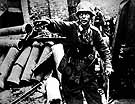
|
|
|

|

|

|

|
|
Click on an image to see a larger, more detailed picture.
|
|
|
|
|
| 1944: Desperate Acts |

|
pg. 556 |

|
|
|
|
| |
 In August 1944 the by-now largely non-Jewish Polish underground revolted against German troops in the city of Warsaw. Some early triumphs, such as the capture of German soldiers (top photo), were psychologically important, and the Poles were further buoyed by the nearness of Soviet troops.
In August 1944 the by-now largely non-Jewish Polish underground revolted against German troops in the city of Warsaw. Some early triumphs, such as the capture of German soldiers (top photo), were psychologically important, and the Poles were further buoyed by the nearness of Soviet troops.
Photo: United States Holocaust Memorial Museum Photo Archive
|
 Instead of sending his forces into Warsaw as soon as possible, Soviet leader Joseph Stalin ordered his troops to wait outside the city, until the Germans had crushed the uprising.
Instead of sending his forces into Warsaw as soon as possible, Soviet leader Joseph Stalin ordered his troops to wait outside the city, until the Germans had crushed the uprising.
Photo: Hulton Getty Images
|
 However, in September Stalin did allow British and American planes to use Soviet airfields to drop badly needed food and materiel to the beleaguered Poles. Much of what was air-dropped fell into German hands, and Stalin suspended Allied use of Russian airfields after only a week. Other Allied flights originating from Foggia, Italy, ironically flew within sight of Jews and others interned at Auschwitz. By October, the Warsaw revolt had been put down.
However, in September Stalin did allow British and American planes to use Soviet airfields to drop badly needed food and materiel to the beleaguered Poles. Much of what was air-dropped fell into German hands, and Stalin suspended Allied use of Russian airfields after only a week. Other Allied flights originating from Foggia, Italy, ironically flew within sight of Jews and others interned at Auschwitz. By October, the Warsaw revolt had been put down.
Photo: Hulton Getty Images
|
|

|

|

|

|
 September 3-5, 1944: Anne Frank is among 1019 Jews deported on the last transport from the Westerbork, Holland, camp to Auschwitz; See September 6, 1944.
September 3-5, 1944: Anne Frank is among 1019 Jews deported on the last transport from the Westerbork, Holland, camp to Auschwitz; See September 6, 1944.
|
 September 4, 1944: At Lugos, Hungary, hundreds of Jews are massacred by Hungarian Fascists.
September 4, 1944: At Lugos, Hungary, hundreds of Jews are massacred by Hungarian Fascists.
|
 September 4, 1944: The Allies capture the Belgian port of Antwerp.
September 4, 1944: The Allies capture the Belgian port of Antwerp.
|
 September 5, 1944: False rumors of imminent liberation in Holland cause Dutch Nazis to flee. The day becomes known as Dolle Dinsdag (Mad Tuesday).
September 5, 1944: False rumors of imminent liberation in Holland cause Dutch Nazis to flee. The day becomes known as Dolle Dinsdag (Mad Tuesday).
|
 September 5, 1944: The SS closes the concentration camp at s' Hertogenbosch, the Netherlands.
September 5, 1944: The SS closes the concentration camp at s' Hertogenbosch, the Netherlands.
|
|
|
|
|
| 1944: Desperate Acts |

|
pg. 556 |

|
|
The Holocaust Chronicle
© 2009 Publications International, Ltd.
|
|
